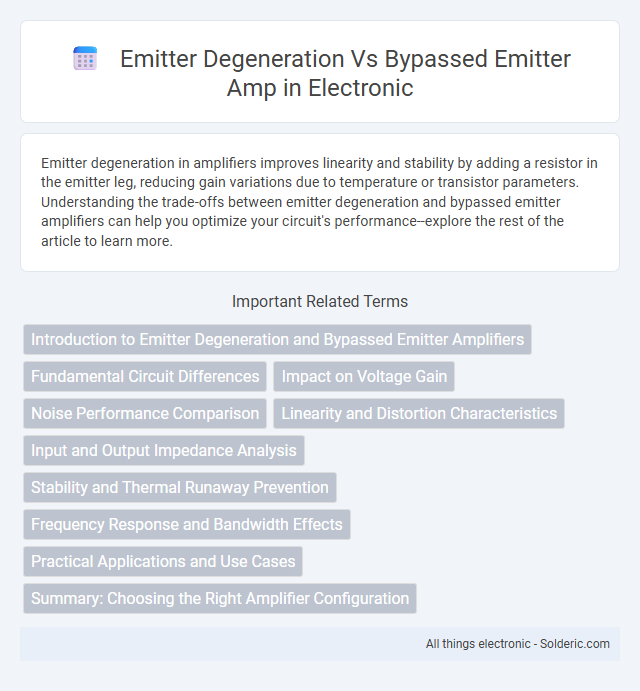Emitter degeneration in amplifiers improves linearity and stability by adding a resistor in the emitter leg, reducing gain variations due to temperature or transistor parameters. Understanding the trade-offs between emitter degeneration and bypassed emitter amplifiers can help you optimize your circuit's performance--explore the rest of the article to learn more.
Comparison Table
| Feature | Emitter Degeneration Amplifier | Bypassed Emitter Amplifier |
|---|---|---|
| Gain Stability | High stability due to negative feedback | Higher gain but less stable |
| Voltage Gain | Moderate, controlled by emitter resistor | Maximum gain, emitter resistor bypassed by capacitor |
| Linear Distortion | Reduced distortion | Higher distortion |
| Bandwidth | Wider bandwidth | Reduced bandwidth due to bypass capacitor |
| Thermal Stability | Improved thermal stability | Less thermal stability |
| Noise Performance | Lower noise | Higher noise |
| Use Case | Precision amplification, where stability is critical | High gain applications where stability is less critical |
Introduction to Emitter Degeneration and Bypassed Emitter Amplifiers
Emitter degeneration in amplifiers involves adding a resistor in the emitter leg to enhance linearity and stability by providing negative feedback, which reduces gain variations caused by temperature or transistor parameter changes. Bypassed emitter amplifiers include a capacitor parallel to the emitter resistor, effectively maintaining emitter degeneration at DC while allowing increased AC gain by reducing the AC feedback. Your choice between emitter degeneration and bypassed emitter configurations depends on the trade-off between gain stability and maximum voltage gain in amplifier design.
Fundamental Circuit Differences
Emitter degeneration introduces a resistor in the emitter leg, increasing linearity and stability by providing negative feedback, which reduces gain variations caused by transistor parameter changes. In contrast, a bypassed emitter amplifier places a capacitor parallel to the emitter resistor, allowing AC signals to bypass the resistor and thus boost AC gain while maintaining DC stability. Your choice depends on whether you prioritize consistent gain and linearity (emitter degeneration) or higher AC gain with potential distortion (bypassed emitter).
Impact on Voltage Gain
Emitter degeneration lowers voltage gain by introducing negative feedback through the emitter resistor, stabilizing the amplifier's gain and improving linearity. In contrast, a bypassed emitter resistor effectively removes this feedback at signal frequencies, significantly increasing voltage gain by maximizing the transistor's intrinsic gain. Your choice between these configurations impacts gain stability and distortion, with emitter degeneration favoring precision and the bypassed emitter amp prioritizing higher voltage gain.
Noise Performance Comparison
Emitter degeneration in amplifiers reduces noise by stabilizing the operating point and decreasing transistor gain variation, which lowers distortion and thermal noise contributions. In contrast, bypassed emitter amplifiers exhibit higher gain but increased noise due to the elimination of emitter resistor feedback, allowing greater transistor noise and signal fluctuations. Optimizing noise performance involves balancing degeneration resistance to minimize noise figure without significantly sacrificing gain.
Linearity and Distortion Characteristics
Emitter degeneration significantly enhances amplifier linearity by introducing negative feedback, which reduces gain variations and minimizes harmonic distortion. In contrast, bypassed emitter amplifiers exhibit higher gain but suffer from increased distortion due to the absence of local feedback at the emitter. The trade-off between improved linearity in emitter degeneration and higher signal amplification with greater distortion in bypassed configurations is critical for analog circuit design.
Input and Output Impedance Analysis
Emitter degeneration in amplifiers increases input impedance by adding negative feedback through the emitter resistor, stabilizing the gain and improving linearity. Bypassing the emitter resistor with a capacitor reduces AC impedance at the emitter, resulting in lower input impedance and higher gain but less linearity. Output impedance is typically lower with bypassed emitter configurations due to reduced feedback, while emitter degeneration increases output impedance, enhancing signal fidelity and stability.
Stability and Thermal Runaway Prevention
Emitter degeneration improves stability and prevents thermal runaway by providing negative feedback through a resistor in the emitter leg, which stabilizes the transistor's operating point despite temperature variations. In contrast, a bypassed emitter amplifier sacrifices this feedback to increase gain, making it more prone to instability and thermal runaway risks. You benefit from enhanced reliability and predictable performance by choosing emitter degeneration for thermal stability and consistent biasing.
Frequency Response and Bandwidth Effects
Emitter degeneration in amplifiers improves linearity and stability but reduces gain, resulting in a wider bandwidth by lowering the amplifier's high-frequency gain roll-off. In contrast, a bypassed emitter amplifier maximizes gain by short-circuiting the emitter resistor at high frequencies, increasing bandwidth and improving high-frequency response but potentially sacrificing linearity and increasing distortion. Frequency response in emitter degeneration tends to be flatter with extended bandwidth, while bypassed emitter designs exhibit higher gain peaks and faster roll-off outside the intended frequency range.
Practical Applications and Use Cases
Emitter degeneration is widely used in amplifier circuits to improve linearity and thermal stability, making it ideal for audio amplifiers and sensor signal conditioning where distortion reduction is crucial. Bypassed emitter amplifiers, featuring a capacitor across the emitter resistor, are preferred in high-gain RF and audio applications where maximizing voltage gain is essential without sacrificing gain bandwidth. In practical terms, emitter degeneration suits precision amplifiers requiring predictable gain and improved input impedance, while bypassed emitters optimize gain performance in dynamic, high-frequency environments.
Summary: Choosing the Right Amplifier Configuration
Emitter degeneration improves amplifier linearity and stability by introducing negative feedback through a resistor in the emitter leg, reducing gain variability due to transistor parameter changes. Bypassed emitter amplifiers maximize gain by short-circuiting the emitter resistor with a capacitor at signal frequencies, sacrificing linearity and stability for higher amplification. Selecting the right amplifier configuration depends on balancing the need for gain against the importance of linearity and thermal stability in the application.
emitter degeneration vs bypassed emitter amp Infographic

 solderic.com
solderic.com